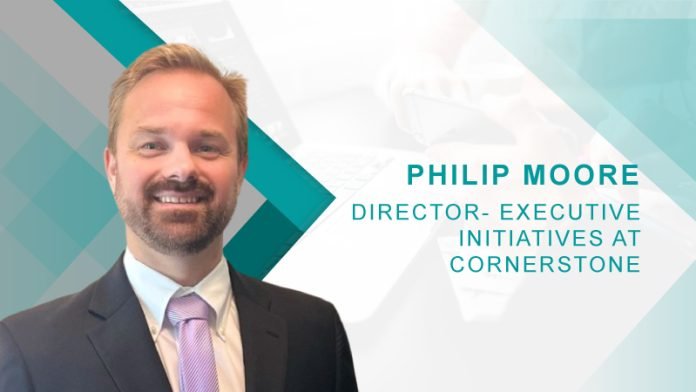Philip, could you please share a bit about your professional journey and how you came to your current role as Director of Executive Initiatives at Cornerstone?
I joined Cornerstone in November of 2023 following 15 years with Novartis Pharmaceuticals where I held a variety of learning and talent management positions, from learning admin, to talent manager, to global product owner. At Novartis, I found my niche was in helping cultivate the intersection between technology, business strategy, and engagement. Specifically, this included helping lead the deployment of both the Cornerstone LMS and the Cornerstone (then EdCast) LXP to our audience of over 100K associates. During this time, I was also closely involved in developing and implementing our cross-functional skills strategy as well. In joining Cornerstone, I’m able to now leverage this real-world experience to provide practitioner-level guidance and lessons learned back to customers, helping them to realize the potential impact of Cornerstone’s L&D solutions.
How would you define the “workforce readiness gap,” and what do you believe are the main factors driving this gap in today’s workplace?
The workforce readiness gap is the fast-growing divide in the skills and agility employees need to adapt to the rapid changes of the modern workplace. As technology and shifting workforce expectations continue to evolve, the workforce can’t keep up with the skills needed to be successful. Multiple factors are driving this gap, including evolving work norms, new technologies, and economic uncertainties. As technological advancements like AI continue at an unprecedented pace, employers cannot keep up with the pace of change, leading to the readiness gap.
One of the primary reasons for the growing skills gap, though, can be attributed to a disconnect from employers and leaders on what employees require. According to recent research from Cornerstone only 45% of leaders recognize the skills gaps within their organizations. If leaders are unaware of the skills gaps within their organizations, they are unable to address and fix the issues that are affecting business performance. In fact, the report also found that 72% of employers feel that the lack of visibility into skills puts a burden on an organization.
Could you describe the specific challenges that small and mid-sized businesses (SMBs) face when adapting to the rapid changes in the modern workplace, and why workforce agility is particularly critical for them?
Small and mid-sized businesses (SMBs) face unique challenges when addressing the workforce readiness gap, all centered around the pace of change. Workforce agility is particularly crucial for SMBs to keep them competitive with larger companies, and even use this pace of change as an advantage.
Firstly, larger companies, with typically larger existing customer bases and recurring revenue, can better withstand changing market dynamics and afford to be slower to adapt, at least compared to SMBs. Yet, with workforce agility, SMBs can use this to their advantage by more quickly responding to shifting consumer demand to create competitive advantage and gain market share.
Secondly, technological changes and advancements, particularly surrounding AI, make it difficult for SMBs to keep up with larger companies that have access to more resources to implement the latest technology. The good news is SMBs could have an advantage over larger counterparts as they can adopt new technologies quicker If employees at smaller businesses can build the skills to take advantage of these new technologies, they will be more productive, leading to the greater chance of innovation and revenue generation for their companies.
Lastly, talent attrition and skill drain can have a more significant impact on SMBs as there tends to be a higher dependency on a smaller concentration of expertise. Moreover, the internal talent pools by definition are smaller, and they don’t always have the resources to fill skill gaps via purchasing power (especially for skills sets which are already at a deficit in the labor market.) As baby boomers continue to retire, SMBs will continue to feel this natural attrition more acutely. Workforce agility not only increases retention, but also prepares the next generation of talent to step into these roles and to maximize the skill sets you have internally by flexing them to the areas of highest demand.
Based on your experience, what are some effective ways companies can create a culture of continuous learning and innovation to ensure their employees’ skills remain up to date?
First and foremost, organizations, leaders, and managers must make time for learning. It cannot be seen as an add-on, something to do only in the margins or in personal time, but a core part of everyone’s job. This is easier said than done, but the oldest challenge in the book is still one of the most relevant. Beyond this, in my experience, the most effective way for companies to create a culture of continuous learning is to make development a personal experience, matching the wants and motivations of individuals with broader organizational need. When done effectively, this creates a strong sense of belonging and engagement, while simultaneously supporting business strategy. The trick is creating this personalized experience at scale. There are many strategies to do so, including:
- Identifying necessary skills needs: The first step to developing a strong learning and development program is to identify the skills needs within an organization. Once these skills gaps are recognized, employers can then focus on the best way to develop employees. There is not a one-solution-fits-all approach learning, therefore it is essential to adapt programs to the needs and learning styles of individuals (especially in a multi-generational workforce).
- Offer career progression opportunities linked to learning: While offering a tailored learning and development program will kickstart learning within an organization, employees will be more motivated to participate in development initiatives with a specific, personal goal to track towards. If employers show employees why skills development is important by connecting it with promotion or growth opportunities, it will give employees a tangible reason to continuously seek out learning opportunities.
- Orchestrate social learning initiatives: Outside of traditional learning and development methods, like online courses or video series, creating an environment of continuous learning means bringing together the entire company to contribute to the same goal of workforce agility. To do so, companies can integrate elements of social learning into their training strategy, such as dedicated communities of practice or robust mentoring and coaching programs with experts.
Implementing these strategies into a skills development program will lay the foundation for a culture of continuous learning. It will motivate employees to actively participate in training, meet professional goals and engage with co-workers in a communal learning environment.
Why do you think traditional training methods are falling short, and what are the main reasons for the disconnect between employer confidence in skill development and employee satisfaction with the training they receive?
Traditional training methods are falling short because they lack a tailored and engaging approach to skills development. A one-size-fits-all training program is likely to not engage or motivate employees. For training methods to work, employees must be active and engaged in the learning. Personalized learning is key to engaging employees in their own development journey, but only 16% believe skill development initiatives are truly tailored to their own personal growth.
Furthermore, employers and employees are misaligned on the efficacy of development programs. Cornerstone’s data also revealed that 80% of leaders believe their workforce receives adequate training, but less than half (42%) of employees agree. This disconnect stems from the type of training employees are receiving. If employers are providing generalized training addressed to all employees, regardless of individual skill level, a major disconnect is likely to exist. Offering blanket training also puts employees who lack certain skills at a disadvantage as it is not guaranteed the generic training will include the skills they are looking to develop. Too often, still, the focus of training today is compliance and completion, rather than impactful learning and development.
In what ways can AI-powered tools revolutionize talent development, particularly in terms of identifying skill gaps, offering personalized learning experiences, and enhancing engagement?
AI-powered tools have and will continue to revolutionize talent development given their data gathering and analysis capabilities. Solutions such as Cornerstone Learn, can quickly gather and review employee data and provide actionable insights on where skills gaps exist. Once skills gaps are identified, AI can provide personalized learning recommendations that specifically target the skills individuals want to develop, aligned to the company’s goals.
During a time when employee engagement is at an all-time low, companies are constantly looking for ways to reengage workers. One solution is to provide opportunities to thrive within the company by connecting development to career mobility and advancement. Leveraging an AI powered talent marketplace, enables employees to chart their own career path, identify new opportunities matched to their unique skill profile, and even take short-term projects to learn and development in adjacent areas. This is especially powerful for GenZ where you can replicate the type of gig economy internally which is becoming more the norm for this generation. If employees know their learning efforts will help them develop key skills to reach their next career step they become more engaged not only in continuous learning but in their work as a whole.
How are AI technologies becoming more accessible and affordable for SMBs, and how can these businesses use AI to bridge the workforce readiness gap?
AI is an essential tool for businesses looking to bridge the workforce readiness gap and provides a great opportunity for SMBs looking to keep up with larger companies. As AI technology continues to be developed and widely implemented, the challenge is no longer having affordable access to AI, but rather building the skills and new ways of working that fully take advantage of it.
For SMBs specifically, AI’s capability to quickly gather and analyze employee skills data is a quick, easy and cost-effective solution for smaller companies who may not have the resources to hire more personnel or outside consultancy to carry out these tasks. On a similar note, AI solutions can use this data to develop tailored and relevant programs and career pathways for each employee, which is also time consuming and costly when done manually.
Would you be able to share some of your personal strategies for staying ahead in the rapidly changing landscape of workforce development and technological advancements?
While it’s always valuable to stay attuned to industry news and upcoming trends, for myself, the best way to stay ahead is to gravitate to experts and practitioners who are actively trying to solve these problems. I’ve always found Socratic dialogue (learning through conversation and questions) such an effective method to learn. Not only do you gain knowledge from these experts, but hearing about the real-world context and challenges – use cases, case studies, successes and failures – is so much more meaningful than just reading about concepts.
In this same vein, another strategy is to listen to customer conversations and learn about the challenges they face with workforce development and new technology. From these conversations, I am personally able to develop a better understanding of what companies may be looking for in the future and what potential solutions they propose for staying ahead. It’s fascinating to both see common themes but also unique challenges across different industries, regions, and company sizes.
What advice would you offer to business leaders who are struggling to keep up with the pace of change and are looking to enhance their workforce’s readiness and agility?
For business leaders struggling to keep up with the pace of change, it is important to identify skills gaps early and be open to implementing new technologies.. As discussed, a major burden companies face when trying to address the growing skills gap is not knowing which gaps exist. It is important to continuously take inventory of company needs and skills development progress to tailor learning strategies as needed. Investing in new technologies leveraging AI can be an effective way to do this.
But technology alone won’t deliver workforce agility. Workforce agility needs to be seen through the lens of individuals as well as the organization. Creating time, space, and priority for leaders to really listen to their teams’ needs, for employees to learn and develop, and to backing this up by creating opportunities to leverage new skills, are essential cultural elements that must be in place to take advantage of even the best technologies and development programs.
As we conclude, what are your final thoughts on the future of workforce development? What key trends should businesses be paying attention to in the coming years?
The future of workforce development is poised to undergo significant transformations driven by changing workforce demographics, continued advancements in technology, and evolving socio-economic trends.
While Baby Boomers are working longer, they won’t work forever, and as GenZ continues to enter the workforce, the expectations for employers are going to continue to shift. This includes even what careers look like with the rise of the gig economy and different working models, the expectations of the latest technology, and demands for equity and social responsibility. This will require new skill development and talent management approaches entirely.
In addition to AI, another notable technology trend to track is the promise of extended reality (XR) for learning and development in the workplace. While its popularity within the workplace setting is in the early phases, XR’s ability to provide an immersive learning experience for employees will be an opportunity for companies to uplevel the impact of their development strategies. XR has the potential to not only revolutionize the way we learn but the way we work, further creating the need for new skills.
Lastly, and most importantly, the fact that the readiness gap is not just a short-term challenge but a trend that’s only going to increase. Many organizations rightly responded to the engagement challenges of the pandemic by increasing their commitment to people, culture, and development. With increasingly uncertain socio-political and economic conditions however, we are seeing a swing back in this commitment in favor of cost optimization. Organizations though who invest according to a long-term view of employee engagement, skill building, and the labor market will be the winners. Yet, with the right culture and right technology, this investment will not only benefit employees but the bottom line as well, through retention, productivity, and workforce agility.
Explore HRtech News for the latest Tech Trends in Human Resources Technology.

Philip Moore Director- Executive Initiatives at Cornerstone
Phil Moore is the Director of Executive Initiatives at Cornerstone, where he is on a mission to bridge the gap between theory and business reality, equipping practitioners with the tools they need to drive real results. Phil has over 15 years of experience implementing talent, learning, skills, and content strategies within the life sciences industry. His passion is to see HR move beyond conceptual discussions or ‘check-the-box’ approaches and focus on meaningful, practical solutions. At the heart of that passion is a belief that thoughtfully engaging people in their development creates happier individuals and drives better business outcomes.












